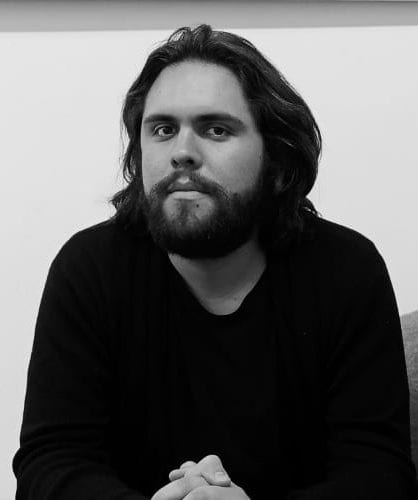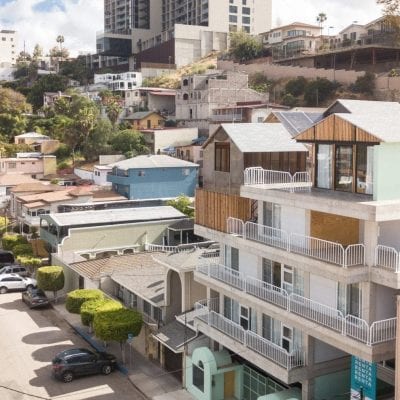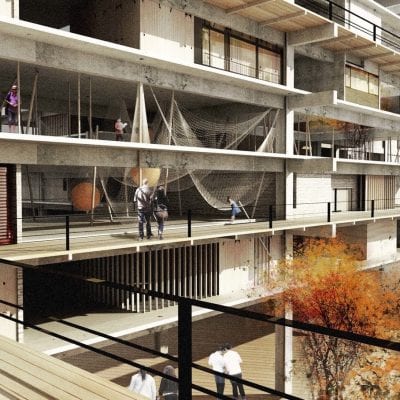Joseph Ruiz Tapia on Designing New Housing Models for Modern Life
Alumnus Joseph Ruiz Tapia (BArch ’13) has studied and worked around the world, from Germany and Spain to the United States and Mexico. Joseph has focused his architectural career in creating housing typologies for cities like New York, Los Angeles, Tijuana, and Mexico City. As the Office Director of T38 Studio in New York for 7 years, he led several projects with a thorough understanding of the efficiency of space, economics, and aesthetics. We recently caught up with Joseph to discuss how he is reevaluating housing practices in contemporary cities and creating alternative models for urban dwellings.
Interview with Joseph Ruiz Tapia
 Why did you choose to study architecture?
Why did you choose to study architecture?
Ever since I was a little kid I was interested in drawing and building things. I could not have a piece of paper in front of me and not draw over it. Books, notebooks, even my school desk were full of lines and figures. I would do this every time I was not interested in what was being taught in class (this happened very often). Looking back on that though, I think what I cherish the most from having studied architecture is how it opened up my understanding of the world through other creative practices such as design, art, and music.
You have a diverse background in construction and architecture, and you’ve worked on projects across North America and Europe. How does this global context shape your work?
I have always thought that architectural practices should not be limited to physical or conceptual borders. In the end, any creation is only completed once it is consumed by its users, physically, emotionally and intellectually, and humans are humans in any part of the world. Having grown up in a border city, living in Tijuana, Mexico, helped me understand this. Very often what we build in Mexico involves a lot of creative decisions taken on the field that inform our more conceptual practice in New York and vice-versa.
As the Office Director of T38 Studio, you’ve had firsthand experience with developers and bringing projects to life. How do you see construction and real estate development evolving over the coming years?
I think there have been many technological advances that facilitate the way we live; in transportation, hospitality, finance, even categorizing the internet as the ultimate public space. On the other hand, I would argue that the construction and development industries have not truly taken a significant step forward, at least not at the scale of the masses, to become more efficient, accessible, and innovative. I am very interested in bringing new models of housing into the sharing economy, which I believe is the future. And all the industries that are involved in the making of cities should turn their shift towards this.
Architects often face questions of narrowing project scopes. With changes to climate, technologies, and construction techniques, how do you think architects and designers will adapt ways of practicing to advance the profession?
I think there is still plenty of space for different kinds of professional practices in the architectural field. There are benefits in narrowing scopes and putting great knowledge on very specific aspects of the architecture spectrum, thinking that as technology advances, compatibility between the different scopes of architecture will impact the end result. But I believe more in a highly comprehensive/integrated way of practicing. There must be an understanding of how we impact not only the neighborhoods where we come in but the planet in general. Working in a more vertically-integrated manner allows us to understand how to build better, economically, politically, and socially, and how this impacts our neighborhoods, cities, and ultimately, the planet.
What type of projects have you enjoyed working on most?
A project we just finished almost a year ago which is the first ground-up shared-living building in Tijuana, Mexico- Casa Uno. As I have mentioned before, growing up in Tijuana and working in New York and Tijuana helped me open up the approach I had as a designer, moving away from a very rationalized aesthetic drive and purist take on architecture to one that is more organic and rooted in the process of creating. This building, in particular, helped me understand the beauty of processes that take us to the end result. It is a collage of informed decisions that reflect the development side of our practice.
What advice would you give to students and young designers who aspire to follow a similar career path?
Be extremely open-minded to the many ways of practicing architecture. Whatever we learn in school is a great way to start shaping us as human beings and professionals, but you need to be open to taking other approaches that might question what we have learned in school. Look into the many other creative fields (music, art, graphic design, etc.) for inspiration and these channels to understand and make architecture. Also, question yourself about the things you are learning and what you are interested in as an individual. In the end, an architectural career can lead you to working in many creative fields. Always make sure you are enjoying what you are doing.
What three words would you use to describe Woodbury?
Diverse. Forward-thinking. Flexible.

